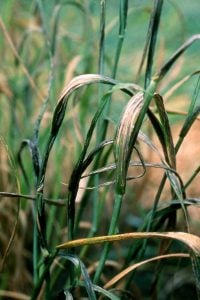Historically flag smut, caused by the fungus Usrocystis agropyri, was an important disease of wheat in Victoria. However, in recent years this disease has been controlled with the use of resistant varieties and treatment of seed with fungicides. Losses from flag smut of wheat, when the disease occurs, are generally in the range of 5 to 20 per cent, however complete crop losses can occur.
What to Look For
Flag smut is characterised by long, black raised streaks on the leaves, leaf sheaths, awns and sometimes on the stems. These black streaks break through the plant tissue, revealing a mass of powdery grey-black spores which easily rub off onto a finger .

Characteristic symptoms of flag smut in wheat are the black lines along the leaves that can easily rub onto a finger leaving a black mark
Infected plants are often stunted so they are not always easily identified in the crop during the season. As well as being stunted, infected stems are often distorted and seldom produce heads. Infected leaves do not expand fully and remain rolled and twisted. Infected plants may produce many tillers, but not all tillers on a plant will exhibit symptoms.
Disease Cycle
During harvest the black spores are released from the plant contaminating both seed and soil. Typically, spores survive in soil for 3 years, but can survive for up to 7 years.
Soil or seed borne spores infect the new wheat plant before emergence. Infection is favoured by early sowing into relatively dry and warm soils. Optimal temperature for infection is 20°C, but infection may occur at as low as 5°C and as high as 28°C. The fungus grows inter and intra cellularly between vascular bundles of the leaf tissue and other effected plant parts.
Control
The regular use of fungicide seed treatments will control this disease. Avoiding the more susceptible varieties will also help control flag smut. Consult a current cereal disease guide for flag smut resistance/susceptibility ratings. See further information section for details. Following a flag smut outbreak, it is important not to sow wheat back into that paddock for several years and source clean seed.


